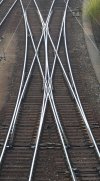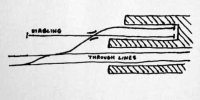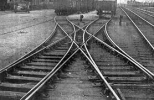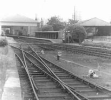Are double slips ever used in new trackwork? At one time they were widely used at the throats of goods yards as the start of the fan of sidings, simultaneously providing the entry to the headshunt in the opposite direction. They save space compared wiith sequential points.
-
Our booking engine at tickets.railforums.co.uk (powered by TrainSplit) helps support the running of the forum with every ticket purchase! Find out more and ask any questions/give us feedback in this thread!
You are using an out of date browser. It may not display this or other websites correctly.
You should upgrade or use an alternative browser.
You should upgrade or use an alternative browser.
Double Slips
- Thread starter Lucan
- Start date
- Status
- Not open for further replies.
Sponsor Post - registered members do not see these adverts; click here to register, or click here to log in
R
RailUK Forums
Sorry, can't answer specifically, but any form of complex pointwork is only used if there is no alternative. Maintenance is more costly and specialist parts are required if something needs replacing.
For example, the new layout at Kings Cross has eliminated slips.
For example, the new layout at Kings Cross has eliminated slips.
Gostav
Member
- Joined
- 14 May 2016
- Messages
- 420
And double slips usually have a sharp curve which severely limited the passing speed.
Western 52
Member
Not sure about new layouts, but to the west of Cardiff Central there are about 5 double slips and a similar number of single slips. Given the number of running lines there and the need for flexible routing, maybe they were the only solution. Perhaps they would have to be renewed as they are at some point?
edwin_m
Veteran Member
Cardiff was re-signalled and re-modelled a couple of years ago, and I think this included the west end. If that's right then there would have been no alternative to the double slips in this area.Not sure about new layouts, but to the west of Cardiff Central there are about 5 double slips and a similar number of single slips. Given the number of running lines there and the need for flexible routing, maybe they were the only solution. Perhaps they would have to be renewed as they are at some point?
Wilts Wanderer
Established Member
- Joined
- 21 Nov 2016
- Messages
- 2,522
Cardiff was re-signalled and re-modelled a couple of years ago, and I think this included the west end. If that's right then there would have been no alternative to the double slips in this area.
I don’t think the West end was touched.
They are classic for 1950-60s layouts (Frankfurt and Zurich as examples) but I have noticed that new layouts avoid them and go for plain S&C - Erfurt has none, Wien Hbf a handful, for example.Funny that continental European railways seem to manage these without issue, on mainstream running lines; Switzerland and Germany in particular. There must be dozens on the approach to Frankfurt Hbf.
One of the upsides of the Euro-style long diagonal crossing tracks, with a double slip at each line crossed, apart from its total flexibility, is a train being switched only makes one turn in each direction. With sequential single crossovers there is a string of left-right-left-right, which must be more wearing on the rolling stock, and sideways thrusts on the track. Noticeable, for example, on the Down Main approaching Didcot, turning to the Oxford avoiding line, a series of lunges and lurches, and squeals from the gangways, as each single turnout in succession is taken - seven required, I think.
Annetts key
Established Member
On late BR / Railtrack/ Network Rail infrastructure, now only installed where it’s too tight (space wise) for alternative layouts.Are double slips ever used in new trackwork? At one time they were widely used at the throats of goods yards as the start of the fan of sidings, simultaneously providing the entry to the headshunt in the opposite direction. They save space compared wiith sequential points.
The bulk handling terminal at Avonmouth, Bristol has some. These were installed in 1992.
One of the upsides of the Euro-style long diagonal crossing tracks, with a double slip at each line crossed, apart from its total flexibility, is a train being switched only makes one turn in each direction. With sequential single crossovers there is a string of left-right-left-right, which must be more wearing on the rolling stock, and sideways thrusts on the track. Noticeable, for example, on the Down Main approaching Didcot, turning to the Oxford avoiding line, a series of lunges and lurches, and squeals from the gangways, as each single turnout in succession is taken - seven required, I think.
....but the speed through the Didcot East ladder is (actually) 70mph, like Hanslope on the WCML.
Better a gentle lurch surely, than an approach controlled 20mph?
WAO
What do we call in this country crossings with double slips where the point-ends are outside the trapezium (?) of the crossing, as in the accompanying picture (courtesy of Wikipedia)? They're "doppelte Kreuzungsweichen mit außenliegenden Aungen" in German, and not uncommon, although recognised as particularly (and perhaps undesirably?) complicated. Their advantage seems to be that they allow higher speeds — as far as I've noted, 60 km/h rather than the 40 km/h or lower of traditional slips.


I have no idea what the answer to your question is, but I'd call the "trapezium (?)" a rhombus - four sides, all equal in length, and each parallel to the opposite one.What do we call in this country crossings with double slips where the point-ends are outside the trapezium (?) of the crossing
Railsigns
Established Member
- Joined
- 15 Feb 2010
- Messages
- 2,521
A "semi-outside double slip".What do we call in this country crossings with double slips where the point-ends are outside the trapezium (?) of the crossing, as in the accompanying picture (courtesy of Wikipedia)?
Dunfanaghy Rd
Member
Outside double slips. The more usual form is an inside double slip. Damn nuisance to maintain either way.
Pay
Pay
edwin_m
Veteran Member
If I recall correctly there's an outside double slip underground at Heathrow T123 (National Rail not Piccadilly Line).
Along with another frowned-upon piece of ironmongery, the scissors crossover, they are more likely to be found underground because the extra complexity of track might simplify the tunneling.
Along with another frowned-upon piece of ironmongery, the scissors crossover, they are more likely to be found underground because the extra complexity of track might simplify the tunneling.
AlbertBeale
Established Member
If I recall correctly there's an outside double slip underground at Heathrow T123 (National Rail not Piccadilly Line).
Along with another frowned-upon piece of ironmongery, the scissors crossover, they are more likely to be found underground because the extra complexity of track might simplify the tunneling.
There's a scissors crossover on the Bakerloo Line, north of Lambeth North (just north of where the ramp down from the London Road sidings joins the northbound track). I have a feeling they're not that uncommon on the Underground?
I note the subtlety of the German one pictured (a type I've seen elsewhere on the continent) - although it might be an outside slip not an inside, and the two slips don't overlap, they do meet in the middle, with the same stretch of line being briefly the left-hand line of one slip and the right-hand line of the other.
If you look closely you will see that they are two separate rails, albeit machined to fit together. A remarkable piece of geometry regardless!There's a scissors crossover on the Bakerloo Line, north of Lambeth North (just north of where the ramp down from the London Road sidings joins the northbound track). I have a feeling they're not that uncommon on the Underground?
I note the subtlety of the German one pictured (a type I've seen elsewhere on the continent) - although it might be an outside slip not an inside, and the two slips don't overlap, they do meet in the middle, with the same stretch of line being briefly the left-hand line of one slip and the right-hand line of the other.
Very common in Germany - almost unheard of here!
That's called a Baesler double slip.What do we call in this country crossings with double slips where the point-ends are outside the trapezium (?) of the crossing, as in the accompanying picture (courtesy of Wikipedia)? They're "doppelte Kreuzungsweichen mit außenliegenden Aungen" in German, and not uncommon, although recognised as particularly (and perhaps undesirably?) complicated. Their advantage seems to be that they allow higher speeds — as far as I've noted, 60 km/h rather than the 40 km/h or lower of traditional slips.
View attachment 110773
O L Leigh
Established Member
I don’t think the West end was touched.
It was in terms of resignalling, but the track layout was left largely unchanged. I don't think there would have been any way to have fitted the necessary pointwork to have allowed access to the "Brickyard siding" from the Down platforms as well as preserve access to Canton depot in order to get rid of the slips.
A double slip is much shorter overall than having two points back to back for the same function. So when you need to dig tunnels to accommodate them, or have other space constraints, the double slip has its advantages. Here is my crayon diagram of a double slip used at the throat of a pair of bay platforms, allowing direct access to a stabling siding for both. Speed is not an issue, and it saves space. If you substitute (or add) goods sidings this was the typical layout of a country station with a small goods yard in steam days; the "stabling" siding would have been the headshunt, and the through lines would have had a second crossover at the far end of the station to provide the loco run-round.Along with another frowned-upon piece of ironmongery, the scissors crossover, they are more likely to be found underground because the extra complexity of track might simplify the tunneling.

Tumbleweed
Member
- Joined
- 17 Apr 2013
- Messages
- 170
There used to be a Double Slip at the Cwm Colliery sidings in Beddau, as a train-mad child at the time I'll never forget this BR brake van crossed it when the rails were in a 'closed' position to the oncoming tram, as it was a manual set up the tram just forced it open with little effort!
Western 52
Member
Cwm Colliery and coke works also had an extensive narrow gauge system. That prompts me to ask if double slips have been used for narrow gauge anywhere? I don't remember seeing one.
Western Sunset
Established Member
Surely would be all one word "Doppeltekreuzungsweichenmitaußenliegendenaungen"What do we call in this country crossings with double slips where the point-ends are outside the trapezium (?) of the crossing, as in the accompanying picture (courtesy of Wikipedia)? They're "doppelte Kreuzungsweichen mit außenliegenden Aungen" in German, and not uncommon, although recognised as particularly (and perhaps undesirably?) complicated. Their advantage seems to be that they allow higher speeds — as far as I've noted, 60 km/h rather than the 40 km/h or lower of traditional slips.
mit milch

Western Sunset
Established Member
A new scissors crossover and a three-way point were laid over the past couple of years at the entrance to Southampton Maritime Container Terminal, when the sidings were extended.
Worth noting that in the German speaking world, a doppelte Kreuzungsweiche is usually shortened to DKW while a single slip is a einfache Kreuzungsweiche (EKW). The ones referenced up thread are commonly known as a Bäseler DKW after the inventor, Wolfgang Bäseler as well as DKW mit außenliegenden Zungen.
Or even more simply as DKW-500-1:9 (or EKW as the case may be), with the 500 giving the radius and the 1:9 the crossing-angle. They were introduced in 1935 as one of the DR standard designs. "Normal" slips were of a 190-metre radius.Worth noting that in the German speaking world, a doppelte Kreuzungsweiche is usually shortened to DKW while a single slip is a einfache Kreuzungsweiche (EKW). The ones referenced up thread are commonly known as a Bäseler DKW after the inventor, Wolfgang Bäseler as well as DKW mit außenliegenden Zungen.
Yes exactly Senex - as someone who has grown up in part with German railways I have always liked the technical clarity they use. I would expect at an engineering level that is universal on the railway given the need for clearly defined geometry, though not as common in the enthusiast community as it is in Germany in my experience.
- Status
- Not open for further replies.



